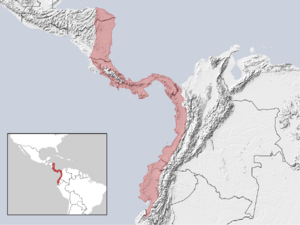Tome's spiny rat facts for kids
The Tome's spiny rat (scientific name: Proechimys semispinosus) is also called the Central American spiny rat. This interesting animal is a type of spiny rat found in Central and South America. It lives in countries from Honduras all the way down to Ecuador. The IUCN says that this rat is a "least concern" animal, which means it's not currently in danger of disappearing.
Quick facts for kids Tome's spiny-rat |
|
|---|---|
| Conservation status | |
| Scientific classification | |
| Genus: |
Proechimys
|
| Species: |
semispinosus
|
| Subspecies | |
|
P. s. burrus Bangs, 1901 |
|
 |
|
| Synonyms | |
|
P. gorgonae Bangs, 1905 |
|
Contents
What Tome's Spiny Rat Looks Like
Tome's spiny rat is a fairly large rat. Its body, from head to tail base, is about 220 to 280 mm (8.7 to 11.0 in) long. Its tail adds another 175 to 192 mm (6.9 to 7.6 in) to its length.
This rat has a long, thin head. It has big, noticeable eyes and narrow ears that stand up straight. If you shine a light on its eyes at night, they glow reddish. This glow comes from a special layer in their eyes called a tapetum lucidum, which helps them see in the dark.
Its feet are long and have strong nails. The rat's fur, called pelage, is smooth. It has spines mixed in with the fur on its back, but these are not very easy to see. The fur on its upper body is reddish-brown, while its belly is white. Its tail has almost no hair and is reddish-brown on top and white underneath. About 20% of these rats might not have a tail at all.
Sometimes, people might confuse this rat with the armored rat (Hoplomys gymnurus). Both are about the same size. However, the armored rat has a longer nose and smaller eyes that don't reflect light as much at night. Other rats that live on the ground are usually much smaller. They also tend to have tails that are longer than their bodies.
Where Tome's Spiny Rat Lives
Tome's spiny rat lives in a wide area. You can find it from the southeastern part of Honduras all the way to southwestern Ecuador. It might even live in northern Peru.
These rats usually live in areas below 800 m (2,620 ft) (about 2,600 feet) in height. But in Ecuador, they can sometimes be found a bit higher up. They are very common in forests that stay green all year and in forests where trees lose their leaves. They especially like areas near rivers and low-lying places.
Tome's spiny rat is a tough and flexible animal. It can adapt to different environments. Because of this, the International Union for Conservation of Nature says it is a "least concern" species. This means it is not in danger of becoming extinct.
Life and Habits of Tome's Spiny Rat
Tome's spiny rat is a nocturnal animal, meaning it is active at night. It mostly lives on the ground. During the day, it finds places to hide. It might hide in a burrow, under a fallen tree, inside a hollow log, or in thick plants.
At night, it moves slowly. It often sits still next to a tree trunk or a log. If it finds itself out in the open, it might freeze and stay completely still.
This rat eats many different things. Its diet includes fruits, seeds, and fungi. It also eats plant material and insects. If it finds a large piece of food, it will carry it to a safe spot before eating it.
Reproduction and Young
Female Tome's spiny rats can have babies up to four times a year. Each time, they can have up to five young. The babies are born precocial, which means they are quite developed and active soon after birth.
How often they have babies seems to depend on how much food is available. For example, on some small islands in Panama, there were fewer births when fruit was scarce. When there was plenty of fruit, many more babies were born. This effect was even stronger when the spiny rat was the only animal eating fruit on the island.
How Tome's Spiny Rat is Related to Other Species
Scientists have studied Tome's spiny rat using its physical features and its DNA. They found that P. semispinosus belongs to a group of Proechimys species called the semispinosus group. It is closely related to another species in this group, P. oconnelli.
| Family Tree of Proechimys Species | ||||||||||||||||||||||||||||||||||||||||||||||||||||||||||||||||||||||||||||||||||||||||||||||||||||||||||||||||||||||||||||||
|
||||||||||||||||||||||||||||||||||||||||||||||||||||||||||||||||||||||||||||||||||||||||||||||||||||||||||||||||||||||||||||||
| This family tree shows how different Proechimys species are related. It was made by looking at their physical traits and their DNA. |
Tome's Spiny Rat and Disease
Tome's spiny rat can carry certain tiny germs called trypanosomes. These germs can cause a disease called leishmaniasis in humans. The disease is spread by small insects called sandflies.
The rat can carry these germs without getting sick itself. This means it can be a "reservoir species," holding the germs and potentially passing them on, even though it looks healthy.
This rat can also host a virus known as Thurisazvirus myis.


